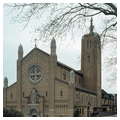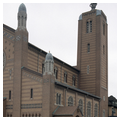Few Pittsburgh architects around World War I were busier than John Theodore Comes (1873–1922), as a dozen local Roman Catholic churches and an additional fifty around the United States testify. A handsome home at 3242 Beechwood Boulevard in Squirrel Hill documents the profitability of his practice. Comes, born in Luxembourg, began his career in Pittsburgh in 1897 with several important projects for himself or for larger firms: St. Augustine's (1899, Comes for Rutan and Russell; 37th Street near Penn Avenue) and St. John the Baptist (1903, Comes for Beezer Brothers; 3501 Liberty Avenue), both in Lawrenceville (the latter now a brewpub); St. Anthony's in Millvale (1914, John T. Comes; 608 Farragut Street); and St. Agnes in Oakland (1917, John T. Comes; 120 Robinson Street)—all are Romanesque Revival variants. After Comes's death in 1922, the firm of Comes, Perry and McMullen put up such highly coloristic Gothic Revival works as St. Bernard's in Mount Lebanon ( AL131). Along the way were occasional forays into modernism, such as St. Josaphat's Church (1909–1916; 2314 Mission Street), a kind of Polish folk-modern, or this church in Munhall, known as Kostol St. Michael to the Slovak community and now part of St. Maximilian Kolbe parish. The gable-fronted church is a stylized and modernized Italian Romanesque Revival constructed of factory-style brick and brightened by hundreds of colored tile inserts. The memorably tall square bell tower is topped with Frank Vittor's aluminum statue of St. Joseph the Worker (1966), which depicts the father of Jesus not as a carpenter but as a steelworker.
You are here
St. Michael the Archangel Church
If SAH Archipedia has been useful to you, please consider supporting it.
SAH Archipedia tells the story of the United States through its buildings, landscapes, and cities. This freely available resource empowers the public with authoritative knowledge that deepens their understanding and appreciation of the built environment. But the Society of Architectural Historians, which created SAH Archipedia with University of Virginia Press, needs your support to maintain the high-caliber research, writing, photography, cartography, editing, design, and programming that make SAH Archipedia a trusted online resource available to all who value the history of place, heritage tourism, and learning.









